|
|
|
|
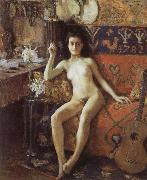 |
Akseli Gallen-Kallela
|
|
April 26, 1865 C March 7, 1931)
Gallen-Kallela was a Finnish artist and designer closely associated with notions of National Romanticism, especially relating to the region of Karelia, also a source of inspiration for the Finnish composer Jean Sibelius. Of particular influence was the collection of folk poems formed in the middle of the 19th century by Elias Lonrot. Following a national competition in 1891 Gallen-Kallela illustrated this national epic known as the Kaleval, the vivid images of which soon became widely known throughout Finland. He also made a significant contribution to the Finnish Pavilion at the Paris Exposition Universelle of 1900 in which he painted frescoes on Kalevala themes in the main dome, as well as designing textiles and furniture. His furniture designs were made by the Iris company, founded by a close friend, Louis Sparre. Like many other ventures associated with Arts and Crafts, the Iris company was concerned with the production of well-designed, well-made furniture and ceramics. Gallen-Kallela designs at Paris 1900 attracted considerable attention leading to the award of a number of Gold and Silver Medals at the exhibition. He worked in a wide range of design media, including ryiji rugs, which he modernized using geometric motifs derived from the Finnish landscape. His distinctive contribution to Finnish culture is preserved in the Gallen-Kallela Museum, which was originally built by him as a studio and family home between 1911 and 1913 and now contains a large body of his work, including paintings, graphics, textiles, jewellery, stained glass, and architectural designs.
|
|
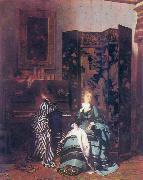 |
Albert von Keller
|
|
Albert von Keller (April 27, 1844 - July 14, 1920) was a German painter.
He was born at Gais, in Switzerland; he studied at the Munich Academy under Lenbach and Ramberg, and must be counted among the leading colorists of the modern German school. Travels in Italy, France, England and Holland, and a prolonged sojourn in Paris, helped to develop his style. His scenes of society life, such as the famous "Dinner" (1890), are painted with thoroughly Parisian esprit, and his portraits are marked by the same elegant distinction. He was particularly successful in the rendering of rustling silk and satin dresses and draperies. His historical and imaginative works were as modern in spirit and as unacademical as his portraits. As of 1911, at the Munich Pinakothek was his painting "Jairi Töchterlein" (1886), while the Königsberg Museum contained his "Roman Bath", and the Liebieg collection in Reichenberg the "Audience with Louis XV", the first picture that drew attention to his talent. Among other important works he painted "Faustina in the Temple of Juno at Praeneste", "The Witches Sleep" (1888), "The Judgment of Paris", "The Happy Sister", "Temptation" (1892), "Autumn" (1893), "An Adventure" (1896), and "The Crucifixion". |
|
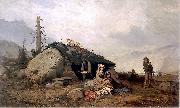 |
Aleksander Kotsis
|
|
- born 1836 in Ludwinew (now one of parts of Krakew), died 1877 in Podgerze (also a part of Krakew now)- was a Polish painter renowned for his landscapes, portraits and genre depictions of contemporary rustic scenes.
In 1850, he attended the Krakew College of Fine Arts, where he studied under Wojciech Stattler.
|
|
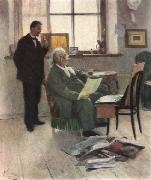 |
Aleksey Korin
|
|
Korin Alexey (1865-1923) -
brief biography
Alexey Korin was born in 1865.
The main themes of his painting were Russian lanscapes, genre-scenes, portraits, interiors.
Studied at the Moscvow School of Painting, Sculpture and Architecture in 1884-1889. Gradueted from this school with big silver medal.
Was the member and took part at the exhebitions of the The Association of Traveling Art Exhibitions (the Itinerants group) since 1891.
Teached at the Moscow School of Painting, Sculpture and Architecture since 1894.
Took part at the World Art Exhibition in Paris in 1900.
Some of the paintings of Alexey Korin were bought by Pavel Tretyakov for his collection. |
|
|
|
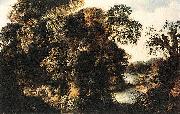 |
Alexander Keirincx
|
|
Alexander Keirincx (Antwerp, 23 January 1600-Amsterdam, 1652) was a Flemish Baroque painter who spent his later career in the Dutch Republic. He became a master in Antwerp's guild of St. Luke in 1619, and like his teacher Abraham Govaerts he initially specialized in small cabinet-sized forest landscapes in the manner of Jan Brueghel the Elder and Gillis van Coninxloo. Also like Govaerts, Keirincx's early works typically show diminutive history, mythological or biblical subjects within a Mannerist three-color universal landscape bracketed by repoussoir trees. However, during the 1620s his landscapes become increasingly natural. He lived in Utrecht and Amsterdam from 1628 until the end of his career, and made trips to England to decorate palaces for Charles I. The figures in his works were usually painted by collaborators such as Cornelis Poelenburg.[1] Keirincx worked primarily as an art dealer later in life. |
|
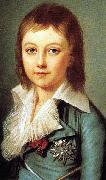 |
Alexander Kucharsky
|
|
Alexander Kucharsky (18 March 1741 - 5 November 1819) also Alexandre Kucharsky, was a Polish portrait painter who spent his adult life in France. He himself used the spelling Kucharsky, but Kucharski is also often used. In the past, in France, the name has been given as Couaski. |
|
|
|
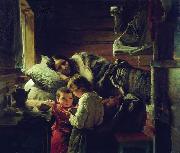 |
Alexei Korzukhin
|
|
(1835-1894) was Russian painter. A Korzukhin 000.JPG
Korzukhin was born in Yekaterinburg on March 23, 1835. In 1858 he began his studies in the St. Petersburg in the Imperial Academy of Arts. In 1860, Korzukhin won his first award for the painting his The Drunken Father.
In 1864, he help found Petersburg Artel of Artists - the "Revolt of Fourteen". Korzukhin has received a rank of the artist of the First Degree for his painting Commemoration on a Rural Cemetery (1865). For The Return of the Father from Fair, he received a rank of the academician. In 1870, he became a founding member of the art group 'The Wanderers.
In 1891 he painted The Lord's Supper for a cathedral in Riga. Korzukhin is perhaps most famous for his many portraits, each of which is characterized to have a subtle psychological depth. For this reason they are generally accepted as masterpieces of Russian portrait painting.
Alexei Korzukhin died in St. Petersburg on October 30, 1894.
|
|
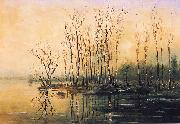 |
Alexej Kondratjewitsch Sawrassow
|
|
Alexei Kondratyevich Savrasov (Russian) (May 24, 1830 - October 8, 1897) was a Russian landscape painter and creator of the lyrical landscape style.
Savrasov was born into the family of a merchant. He began to draw early and in 1838 he enrolled as a student of professor Rabus at the Moscow School of Painting, Sculpture and Architecture (graduated in 1850), and immediately began to specialize in landscape painting.
In 1852, he traveled to Ukraine. Then, in 1854 by the invitation of the Grand Duchess Maria Nikolayevna, President of the Imperial Academy of Arts, he moved to the neighborhood of St. Petersburg. In 1857, Savrasov became a teacher at the Moscow School of painting, sculpturing and architecture. His best disciples, Isaac Levitan and Konstantin Korovin, remembered their teacher with admiration and gratitude.
|
|
|
|
|
|
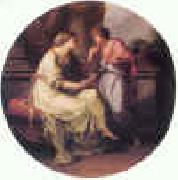 |
Angelica Kauffmann
|
|
Swiss(Resident in England)
1741-1807
She was born at Chur in Graub??nden, Switzerland, but grew up in Schwarzenberg in Vorarlberg/Austria where her family originated. Her father, Joseph Johann Kauffmann, was a relatively poor man but a skilled painter that was often traveling around for his works. He was apparently very successful in teaching his precocious daughter. She rapidly acquired several languages from her mother Cleophea Lutz, read incessantly, and showed marked talents as a musician. Her greatest progress, however, was in painting; and in her twelfth year she had become a notability, with bishops and nobles for her sitters. In 1754 her father took her to Milan. Later visits to Italy of long duration followed: in 1763 she visited Rome, returning again in 1764. From Rome she passed to Bologna and Venice, being everywhere feted and caressed, as much for her talents as for her personal charms.
Writing from Rome in August 1764 to his friend Franke, Winckelmann refers to her exceptional popularity. She was then painting his picture, a half-length, of which she also made an etching. She spoke Italian as well as German, he says; and she also expressed herself with facility in French and English, one result of the last-named accomplishment being that she became a popular portraitist for English visitors to Rome. "She may be styled beautiful," he adds, "and in singing may vie with our best virtuosi." While at Venice, she was induced by Lady Wentworth, the wife of the German ambassador, to accompany her to London. One of her first works was a portrait of David Garrick, exhibited in the year of her arrival at "Mr Moreing's great room in Maiden Lane." The rank of Lady Wentworth opened society to her, and she was everywhere well received, the royal family especially showing her great favour.
Her firmest friend, however, was Sir Joshua Reynolds. In his pocket-book, her name as Miss Angelica or Miss Angel appears frequently, and in 1766 he painted her, a compliment which she returned by her Portrait of Sir Joshua Reynolds. Another instance of her intimacy with Reynolds is to be found in her variation of Guercino's Et in Arcadia ego, a subject which Reynolds repeated a few years later in his portrait of Mrs Bouverie and Mrs Crewe.
When, in about November 1767, she was entrapped into a clandestine marriage with an adventurer who passed for a Swedish count (the Count de Horn), Reynolds helped extract her. It was doubtless owing to his good offices that she was among the signatories to the famous petition to the king for the establishment of the Royal Academy of Painting and Sculpture. In its first catalogue of 1769 she appears with "R.A." after her name (an honour she shared with one other lady, Mary Moser); and she contributed the Interview of Hector and Andromache, and three other classical compositions.
Her friendship with Reynolds was criticised in 1775 by fellow Academician Nathaniel Hone in his satirical picture "The Conjurer". This attacked the fashion for Italianate Renaissance art, ridiculed Reynolds, and included a nude caricature of Kauffmann, later painted out by Hone. The work was rejected by the Royal Academy.
From 1769 until 1782, she was an annual exhibitor, sending sometimes as many as seven pictures, generally classic or allegorical subjects. One of the most notable was Leonardo expiring in the Arms of Francis the First 1778. In 1773 she was appointed by the Academy with others to decorate St Paul's Cathedral, and it was she who, with Biagio Rebecca, painted the Academy's old lecture room at Somerset House.
Kauffmann's strength was her work in history painting, the most elite and lucrative category in academic painting during the 18th century. Under the direction of Sir Joshua Reynolds, the Academy made a strong effort to promote history painting to a native audience who were more interested in commissioning and buying portraits and landscapes. Despite the popularity that Kauffmann enjoyed in English society and her success as an artist, she was disappointed by the relative apathy that the English had for history painting. Ultimately, she left England for the continent where history painting was better established, esteemed, and patronized.
Kauffmann (seated), in the company of other "Bluestockings" (1778)It is probable that her popularity declined a little in consequence of her unfortunate marriage; but in 1781, after her first husband's death (she had been long separated from him), she married Antonio Zucchi (1728?C1795), a Venetian artist then resident in England. Shortly afterwards she retired to Rome, where she befriended, among others, Johann Wolfgang von Goethe, who said she worked harder and accomplished more than any artist he knew, yet always restive she wanted to do more (Goethe's 'Italian Journey' 1786-1788) and lived for 25 years with much of her old prestige. In 1782 she lost her father; and in 1795, her husband. She continued at intervals to contribute to the Academy, her last exhibit being in 1797. After this she produced little, and in 1807 she died in Rome, being honoured by a splendid funeral under the direction of Canova. The entire Academy of St Luke, with numerous ecclesiastics and virtuosi, followed her to her tomb in San Andrea delle Fratte, and, as at the burial of Raphael, two of her best pictures were carried in procession.
The works of Angelica Kauffmann have not retained their reputation. She had a certain gift of grace, and considerable skill in composition. But her figures lack variety and expression; and it has been said that her men are masculine women (it is worth noting that, at the time, female artists were not allowed access to male models). Her colouring, however, is fairly enough defined by Gustav Friedrich Waagen's term "cheerful". As of 1911, rooms decorated by her brush were still to be seen in various quarters. At Hampton Court was a portrait of the duchess of Brunswick; in the National Portrait Gallery, a self-portrait . There were other pictures by her at Paris, at Dresden, in the Hermitage at St Petersburg, and in the Alte Pinakothek at Munich. The Munich example was another portrait of herself; and there was a third in the Uffizi at Florence. A few of her works in private collections were exhibited among the Old Masters at Burlington House. But she is perhaps best known by the numerous engravings from her designs by Schiavonetti, Bartolozzi and others. Those by Bartolozzi especially still found considerable favour with collectors. Also, several of her works can be seen in the game Hitman: World of Assassination in one of the missions, read more on the site Zonemod.
Charles Willson Peale (1741-1827), arist, patriot, and founder of a major American art dynasty, named several of his children after great European artists, including a daughter, Angelica Kauffman Peale. Her life was written in 1810 by Giovanni de Rossi. It has also been used as the basis of a romance by Leon de Wailly (1838) and it prompted the charming novel contributed by Mrs Richmond Ritchie to the Cornhill Magazine in 1875 entitled Miss Angel.
She should not be confused with painter Angelika Kaufmann, who was born in 1935 in Carinthia, Austria.
|
|
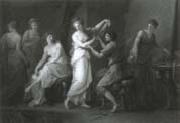 |
Angelika Kauffmann
|
|
1741-1807,Swiss neoclassical painter and graphic artist. From her youth she was known for her artistic, musical, and linguistic abilities. She went to England, where she enjoyed success as a fashionable portrait painter and decorator. A protegee of Sir Joshua Reynolds, Kauffman was one of the original members of the Royal Academy. She often decorated houses designed by the Adam brothers. After her marriage in 1781 to the Venetian painter Antonio Zucchi, she lived in Italy, where she flourished in artistic and literary circles. Reynolds, Winckelmann, Goethe, and Garrick commissioned her to paint their portraits. Representative works include Religion (National Gall., London); Self-Portrait (Staatliche Museen, Berlin); and the etchings of L'Allegra and La Pensierosa. The British Museum has a collection of her drawings and prints. |
|
 |
Anna Elizabeth Klumpke
|
|
1856-1942
Anna Elizabeth Klumpke (October 28, 1856?C1942) was American portrait and genre painter born in San Francisco, California, United States. She is perhaps best known for her portraits of famous women including Rosa Bonheur and Elizabeth Cady Stanton (1889).
Her father, John Gerald Klumpke, born in England or Germany , was a successful and wealthy realtor in San Francisco. Her mother was Dorothea Mattilda Tolle. Anna was the eldest of eight children, five of whom lived to maturity. Among her siblings were the astronomer Dorothea Klumpke-Roberts, the violinist Julia Klumpke, and the neurologist Augusta D??jerine-Klumpke.
At age three, Anna fell and suffered a fracture of her femur. She fell again at age five and suffered osteomyelitis with purulent knee arthritis. It handicapped her, and her mother took extraordinary means to remeded the problem by taking Anna and three siblings to Berlin for treatment by Dr. Bernhard von Langenbeck.
The treatments lasted 18 months, including thermal baths at Kreuznach, but unfortunately they were not successful, and she would remained hobbled all her life. While in Europe, her mother ensured that all of her children had excellent tutoring.
The time away in Europe placed a strain on the relationship of her parents. When Anna was fifteen, her parents divorced. She and her siblings (now numbering five) moved with their mother to Göttingen, Germany, where they lived for a time with Mattilda's sister, who had married a German national. Anna and her sister Augusta were sent to school at Cannstatt, near Stuttgart. At age seventeen, the family moved to Clarens, near Lake Geneva in Switzerland where she spent two years in boarding school. She studied art at home for the next few years, and in October 1877, moved with her family once more to Paris, where she was later enrolled in the Julian Academy (1883-1884), under the tutelage of Tony Robert-Fleury and Jules Lefebvre. At one point she also studied under Vuillefroy. She presented her first work at the Paris Salon in 1884, while still at the Academy, and she won the grand prize for outstanding student of the year. She showed regularly at the Salon for several more years. |
|
|
|
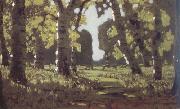 |
Arkhip Ivanovich Kuindzhi
|
|
Russian Painter, 1842-1910
Ukrainian painter, active in Russia. Initially self-taught as an artist, he twice failed the St Petersburg Academy's entrance examination, despite coaching by the marine painter Ivan Aivazovsky. In 1868, however, he was accepted as an external student. He persevered against conservative prejudice and poverty throughout his early career, supplementing his income by retouching photographs. In his early landscape paintings he often sought to capture seasonal moods, as in Autumn Mud (1872; St Petersburg, Rus. Mus.). A more human focus, however, is noticeable after 1874, when he joined the travelling exhibitions society the WANDERERS: the village houses dominate the landscape setting in Evening in Ukraine (1878; St Petersburg, Rus. Mus.). Kuindzhi's principal interest, however, was in lighting, and he obtained striking effects by using vivid colours, chiaroscuro contrasts and simple but cleverly conceived designs. Spectacular paintings, such as the Birch Grove (1879; Moscow, Tret'yakov Gal.), greatly moved contemporary viewers. Through years of experimentation, Kuindzhi developed a highly original technique, which he applied to an increasingly typical, at times almost visionary, treatment of subjects such as snow-covered mountains and moonlight (e.g. Elbnis: Moonlit Night, 1890-95; Moscow, Tret'yakov Gal.). Due to imperfections in the paints he used, many of his canvases soon darkened. |
|
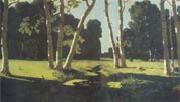 |
Arkhip Kuinji
|
|
was originally a Greek,Then he got to St. Petersburg1842 - 1910 |
|
|
|
|
|
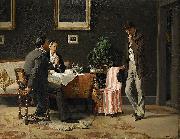 |
Axel Kulle
|
|
painted Den forlorade sonens aterkomst in1882 |
|
 |
Barend Cornelis Koekkoek
|
|
1803-1862
Dutch
Barend Cornelis Koekkoek Gallery
Koekkoek??s own paintings reveal a careful study and synthesis of Dutch seventeenth century painters. His art is firmly rooted in the great Dutch romantic tradition established by the seventeenth-century masters: Hobbema, Cuyp, Ruisdael and Wynants. The golden light and the inclusion of travellers in his work suggests Koekkoek also admired the Dutch Italianate painters of the seventeenth century, collectively known as the Bamboccianti, especially Pieter van Laer and Jan Both.
Koekkoek imagined his pictures as the result of an ideal combination of observation and artifice. He studied art and nature with equal acuity, creating beautiful landscape paintings that celebrated the greatness of Creation. ??Koekkoek's work impresses the spectator by its power, by the firm and correct construction of the trees, by the broad, natural growth of the leaves and boughs, [and] by the careful and elaborate reproduction of the wooded landscape?? (G. H. Marius, Dutch Painters of the Nineteenth Century, Woodbridge, 1973, p. 89). Up to this day, Willem Koekkoek's work is very much favoured for the lively composition and the mood of nostalgia, in which the Dutch Golden Age seems to linger on. Just as he was during his own lifetime, Koekkoek is widely regarded as the most accomplished landscape painter of Dutch romanticism, against whose scrupulously refined paintings the work his contemporaries is measured.
|
|
|
|
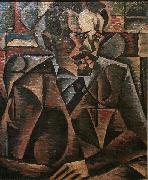 |
Bohumil Kubista
|
|
(1884 - 1918) was a Czech painter and art critic, one of the founders of Czech modern painting. He studied at the School of Applied Arts in Prague, but left in 1906 to study at the Reale Istituto di Belle Arti in Florence. He, Emil Filla, Antonin Prochezka, and five others founded Osma (The Eight), an Expressionist-oriented group of artists.
Kubišta came to his individual expression gradually, at first he was influenced by the work of Vincent van Gogh and Paul Cezanne. He educated himself in in philosophy and optics, and studied colour and the geometrical construction of painting.
Kubišta, like several other Czech artists of his generation, was strongly affected by the 1905 Edvard Munch exhibition in Prague. Together with Emil Filla he established the artistic group Osma in 1907. He worked in an Expressionist style until 1910, and exchanged ideas with German painters in Die Bre - ke. He also developed visual ideas learned from the work of Cezanne. His later style (approximately from 1911) was strongly influenced by cubism and expressionism. Expressionist elements, particularly his use of color but also his subject matter, immediately distinguish Kubištaes cubist work from that of founding Paris Cubists Picasso and Braque. He studied color theory, analyzing the harmonic and compositional principles of painters such as El Greco, Eugene Delacroix, Vincent van Gogh, and Edvard Munch. He also paid close attention to mathematical and geometric principles. Around 1911, he became acquainted with Jan Zrzavý and the artistic group Sursum.
He died prematurely during the global 1918 flu pandemic which ravaged Europe after the First World War.
|
|
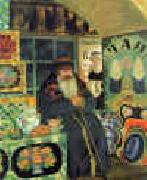 |
Boris Kustodiev
|
|
1878-1927
Russian
Boris Kustodiev Galleries
The Russian Revolution of 1905, which shook the foundations of society, evoked a vivid response in the artist's soul. He contributed to the satirical journals Zhupel (Bugbear) and Adskaya Pochta (Hell??s Mail). At that time, he first met the artists of Mir Iskusstva (World of Art), a group of innovative Russian artists. He joined their association in 1910 and subsequently took part in all their exhibitions.
In 1905, Kustodiev first turned to book illustrating, a genre in which he worked throughout his entire life. He illustrated many works of classical Russian literature, including Nikolai Gogol's Dead Souls, The Carriage, and The Overcoat; Mikhail Lermontov's The Lay of Tsar Ivan Vasilyevich, His Young Oprichnik and the Stouthearted Merchant Kalashnikov; and Leo Tolstoy's How the Devil Stole the Peasants Hunk of Bread and The Candle.
In 1909, he was elected into Imperial Academy of Arts. He continued to work intensively, but a grave illness??tuberculosis of the spine??required urgent attention. On the advice of his doctors he went to Switzerland, where he spent a year undergoing treatment in a private clinic. He pined for his distant homeland, and Russian themes continued to provide the basic material for the works he painted during that year. In 1918, he painted The Merchant's Wife, which became the most famous of his paintings.
The Merchant's Wife, (1918).In 1916, he became paraplegic. "Now my whole world is my room", he wrote. His ability to remain joyful and lively despite his paralysis amazed others. His colourful paintings and joyful genre pieces do not reveal his physical suffering, and on the contrary give the impression of a carefree and cheerful life. His Pancake Tuesday/Maslenitsa (1916) and Fontanka (1916) are all painted from his memories. He meticulously restores his own childhood in the busy city on the Volga banks.
In the first years after the Russian Revolution of 1917 the artist worked with great inspiration in various fields. Contemporary themes became the basis for his work, being embodied in drawings for calendars and book covers, and in illustrations and sketches of street decorations. His covers for the journals The Red Cornfield and Red Panorama attracted attention because of their vividness and the sharpness of their subject matter. Kustodiev also worked in lithography, illustrating works by Nekrasov. His illustrations for Leskov's stories The Darner and Lady Macbeth of the Mtsensk District were landmarks in the history of Russian book designing, so well did they correspond to the literary images. |
|
|
|
|
|
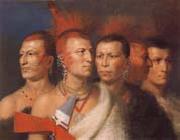 |
Charles Bird King
|
|
American Painter, 1785-1862,is a United States artist who is best known for his portraiture. In particular, the artist is notable for the portraits he painted of Native American delegates coming to Washington D.C., which were commissioned by government's Bureau of Indian Affairs. Charles Bird King was born in Newport, Rhode Island as the only child of Deborah Bird and American Revolutionary veteran Captain Zebulon King. The family traveled west, but when King was four years old, his father was killed and scalped by Native Americans near Marietta, Ohio. King and his mother moved back to Newport to live with Bird's mother. When King was fifteen, he went to New York to study under the portrait painter Edward Savage. At age twenty he moved to London to study under the famous painter Benjamin West at the esteemed Royal Academy. King returned to the U.S. due to the War of 1812 after a seven-year stay in London, and spent time working in Philadelphia, Baltimore, and Richmond. He eventually settled in Washington, due to the economic appeal that the burgeoning city offered. In the nation's new capital, the artist earned a solid reputation as a portraitist among politicians, and earned enough to maintain his own studio and gallery. King's economic success in the art world, particularly in the field of portraiture, had more to do with his ability to socialize with the wealthy celebrities, and relate to the well educated politicians of the time: His industry and simple habits enabled him to acquire a handsome competence, and his amiable and exemplary character won him many friendse . These patrons included John Quincy Adams, John Calhoun, Henry Clay, James Monroe, and Daniel Webster . |
|
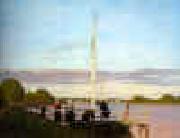 |
Christen Kobke
|
|
1810-1848
Danish
Christen Kobke Galleries
He lived in Kastellet until 1833 and made many paintings of the area. His painting "Gården ved bageriet i Kastellet" (ca. 1832) hangs in the Ny Carlsberg Glyptotek museum in Copenhagen.
In 1832 he shared a studio with friend, landscape painter Frederik Hansen Sødring. He painted a portrait of Sødring which now hangs in the Hirschsprung Collection.
In 1834 he moved, along with his parents, outside of Copenhagen??s fortifications near Sortedamssøen, a lake area. He painted many views overlooking the lake towards the city and the embankments surrounding the city. His work becomes larger, more monumental.
Like many of his contemporary artists he came under the influence of Niels Lauritz Høyen, art historian, who promoted a nationalistic art. Høyen called for artists to search for subject matter in the folk life of their country instead of searching for themes in other lands, such as Italy (which was at that time considered a requirement for an artist??s training). On a visit to Hillerod in 1835 he painted a romantic picture of Frederiksborg Palace, "Frederiksborg Slot ved Aftenbelysning" ("Frederiksborg Palace in the Evening Light").
At the end of 1837 he married Susanna Cecilie Kobke (1810-1849), and shortly afterwards painted a portrait of his young bride.
One of the Small Towers on Frederiksborg Castle, c.1834-35.In 1838 he received a travel stipend from the Academy, left his new wife and traveled over Dresden and Munich to Italy accompanied by decorative painter Georg Hilker. They arrived in Rome by year??s end where he met brother-in-law Frederik Christopher Krohn, sculptor and medallionist, and many other Danish artists. He traveled, along with Constantin Hansen the following summer to Naples, Sorrento, Pompeii and Capri where he painted out in the open air.
He returned home in 1840 with a large collection of sketches for later use and inspiration. Unfortunately, most his later work with these Italian themes was uninspired, and they found little favor. Kobke even considered at the time becoming a decoration painter, having participated in 1844-1845 in the decoration of the Thorvaldsens Museum, a museum dedicated to the artistic works of Bertel Thorvaldsen.
Two years after his father died in 1843 the family sold the property outside Copenhagen, and Kobke moved back into the city. His application for admission to the Academy, which was accompanied by one of his failed Italian landscapes, was rejected in 1846. He died in 1848 of pneumonia, and is buried in Assistens Kirkegard.
Kobke, a national romantic, painted portraits, landscapes and architectural paintings. Most of Kobke??s portraits show friends, family members and fellow artists. He found most of his motifs in his immediate surroundings. Now he is recognized internationally for his well composed and harmonic paintings, for their coloristic qualities and for his sense of the everyday life. But in his lifetime he was almost forgotten, especially because of his early death and limited production. Despite his talent and the praise of various contemporaries, Kobke had never been inundated with commissions.
Kobke is recognized today as one of the most talented among Denmark??s Golden Age painters and the most internationally renowned Danish painter of his generation. The painterly interpretations he made of his surroundings stand as highpoints of the period.
His works are in the collections of not only Danish museums but also such international museums as the J. Paul Getty Museum
|
|
|
|
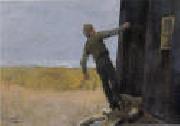 |
Christian Krohg
|
|
1852-1925
Norwegian
Christian Krohg Gallery
Krohg was educated in Germany at the Baden School of Art in Karlsruhe under Hans Gude[1], and later worked in Paris from 1881 to 1882. Inspired by the thoughts of the realists he chose motives primarily from everyday life ?C often its darker or socially inferior sides. Particularly well known are his pictures of prostitutes, and his novel Albertine from 1886 is about this theme. The book caused a scandal when first published, and was confiscated by the police. Krogh??s powerful and straightforward style made him one of the leading figures in the transition from romanticism to naturalism, characteristic of Norwegian art in this period. Through his periodic residence at Skagen, where he arrived for the first time in 1879, he had great influence on Anna and Michael Ancher, and provided early support to Edvard Munch.
Krohg was a journalist in the Oslo newspaper Verdens Gang 1890-1910, where he wrote remarkable portrait interviews. Later he became a professor director at Statens Kunstakademi (The Norwegian Academy of Arts) 1909-1925.
He was married to Oda Krohg. |
|
|
|
|
|
|
|
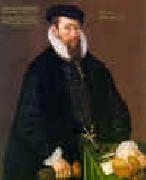 |
Cornelis Ketel
|
|
Flemish (Resident in UK)
1548-1616 Cornelis or Cornelius Ketel (Gouda, 18 March 1548 ?C Amsterdam, 8 August 1616) was a Dutch Mannerist painter, active in Elizabethan London from 1573 to 1581, and in Amsterdam from 1581 to the early 1600s, now known essentially as a portrait-painter, though he was also a poet and orator, and from 1595 began to sculpt as well.
According to Ketel's biography, written by his contemporary Karel van Mander, he seems to have wanted to concentrate on the most prestigious of the hierarchy of genres, history painting, which included mythological subjects, but after he left France he is known almost entirely as a portrait-painter. Neither England nor Holland had much demand for large history paintings during his lifetime, and none of Ketel's histories or allegorical paintings are known to have survived intact, although drawings and prints survive. He did however significantly influence the development of the largest type of painting commonly produced in the United Provinces at this period, the civic group portrait
|
|
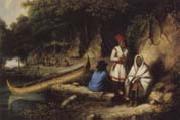 |
Cornelius Krieghoff
|
|
Dutch-born Canadian Painter, 1815-1872
Canadian painter of Dutch birth. He learnt the rudiments of music and painting from his father and about 1830 attended the Akademie der Bildenden Kenste in D?sseldorf. He moved to America c. 1835 and enlisted in the US army. In New York he met Louise Gauthier, a French-Canadian, and settled in Montreal with her in 1840, working as a painter and a musician. In 1842-3 he had a studio in Rochester, NY; in the following year he studied in Paris, making copies in the Louvre. Returning to Canada in 1845, he painted portraits in Toronto, and from 1845 to 1853 he lived in Longueuil and then in Montreal, where he produced genre paintings, landscapes and portraits. He exhibited in Montreal and Toronto, and a series of lithographs were published after his drawings. However, he found it difficult to sell his work in Montreal and had to resort more or less completely to sign-painting for a living. About 1853, at the instigation of the auctioneer John Budden, Krieghoff settled in Quebec City. He lived there for 11 years, making several trips to Europe. During this period of intensive production, he achieved popularity and prosperity and painted his best-known pictures, which were scenes depicting the local townspeople and the North American Indians, and views of Quebec City and the surrounding region. About 1858 he made panoramic paintings of Canada for the Provincial Parliament buildings in Quebec. From 1864 to 1867 he lived in Paris and Munich, |
|
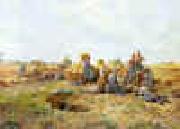 |
Daniel Ridgeway Knight
|
|
1839-1924
Daniel Ridgeway Knight Gallery
Daniel Ridgway Knight was born on March 15,1839 in Pennsylvania. He studied and exhibited at the Pennsylvania Academy of the Fine Arts, were he was a classmate of Mary Cassatt and Thomas Eakins. In 1861, he went to Paris to study at L'Ecole des Beaux-Arts under Cabanel, and to apprentice in the atelier of Charles-Gabriel-Gleyere. |
|
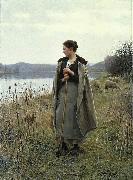 |
Daniel Ridgway Knight
|
|
(March 15, 1839 - March 9, 1924) was an American artist born at Philadelphia, Pennsylvania. He was a pupil at the Ecole des Beaux-Arts, Paris, under Gleyre, and later worked in the private studio of Meissonier. After 1872 he lived in France, having a house and studio at Poissy on the Seine.
Spring BlossomsHe painted peasant women out of doors with great popular success. He was awarded the silver medal and Cross of the Legion of Honor, Exposition Universelle, Paris, 1889, and was made a Knight of the Royal Order of St. Michael of Bavaria, Munich, 1893, and receiving the gold medal of honor from the Pennsylvania Academy of the Fine Arts, Philadelphia, 1893. His son, Louis Aston Knight (1873 - 1948), is also known as a landscape painter.
|
|
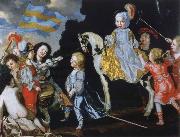 |
David Klocker Ehrenstrahl
|
|
German, 1629-1698,Swedish nobleman and portrait painter who in 1652, at twenty-four years of age, at the request of Carl Gustaf Wrangel, moved to Skokloster Castle, from his art studies in the Netherlands. Between 1654 and 1661 he studied in Italy and visited the courts of both France and England. On his return he became entitled Court painter. He was raised to the nobility in 1674 and became court indendant in 1690. Mikael Dahl and David von Krafft as well as his daughter Anna Maria (born 1666) can be found among his pupils. The allegoric great hall ceiling fresco, named The Great Deeds of The Swedish Kings, in the Swedish House of Knights, made between 1670 and 1675, is considered to be his greatest work. A second version was made in Drottningholm Palace, the home of the Swedish Royal Family, in 1695. The Drottningholm fresco, also became the motive of the 1000th and ever largest postage stamp by Czeslaw Slania, the Polish |
|
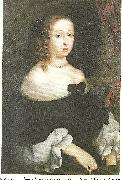 |
david von krafft
|
|
David von Krafft, konstnär, målare, född 1655 i Hamburg, död 1724 i Stockholm.
David von Krafft blev kallad till Sverige 1675 av hofkonterfejaren (hovmålaren) David Klöcker Ehrenstrahl, som dessutom var hans morbror och nu även blev hans lärare i den ädla konsten att måla. Senare studerade von Krafft vidare ett tiotal år i utlandet, särskilt i Italien, slutligen blev han Ehrenstrahls ersättare som hovmålare.
Nu fick han en massa beställningar och uppdrag och han målade sakliga och säkert tecknade porträtt, som tyvärr dock är ganska entoniga och kalla i koloriten. Bland hans bästa arbeten är porträttet av Karl XII (finns i Lund) samt av Carl Gustaf Armfeldt d.ä. (Drottningholms slott). I Kalmar domkyrka har han målat altartavlan (dock efter en komposition av en italiensk konstnär).
David von Krafft finns representerad vid Nationalmuseum, Malmö Museum, Göteborgs konstmuseum och på Gripsholm. Krafft hade ett stort antal lärjungar och bland dem Gustaf Lundberg och Olof Arenius. |
|
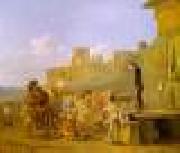 |
DUJARDIN, Karel
|
|
Dutch Baroque Era Painter, ca.1622-1678
Dutch painter and etcher. He studied with Berchem and in Italy. Dujardin was particularly successful in painting landscapes with figures and animals, and he made some 51 fine etchings of similar subjects. |
|
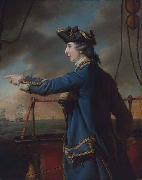 |
Edward Knowles
|
|
(born 1868 in Waberthwaite e died 29 June 1945 in Skiptone) was a rugby union footballer of the 1890s who at representative level played for England, and at club level for Millom,playing in the Forwards, e.g. Front row, Lock, or Back row. Prior to the 1899/1900 season, Millom was a rugby union club.
|
|
|
|
|
|
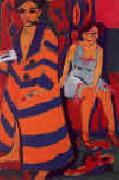 |
Ernst Ludwig Kirchner
|
|
German Expressionist Painter and Sculptor, 1880-1938 was a German expressionist painter and printmaker and one of the founders of the artists group Die Brucke or "The Bridge", a key group leading to the foundation of Expressionism in 20th century art. He volunteered for army service in the First World War, but soon suffered a breakdown and was discharged. In 1933, his work was branded as "degenerate" by the Nazis and in 1937 over 600 of his works were sold or destroyed. In 1938 he committed suicide. In 1913, the first public showing of Kirchner's work took place at the Armory Show, which was also the first major display of modern art in America. In 1921, U.S. museums began to acquire his work and did so increasingly thereafter. His first solo show was at the Detroit Institute of Arts in 1937. In 1992, the National Gallery of Art, Washington, held a monographic show, using its existing collection; a major international loan exhibition took place in 2003. In November 2006 at Christie's, Kirchner's Street Scene, Berlin (1913) fetched $38 million, a record for the artist. |
|
|
|
|
|
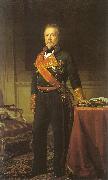 |
Federico de Madrazo y Kuntz
|
|
1815-1894
Spanish
Federico de Madrazo y Kuntz Gallery
Born in Rome, he was the son of the painter Madrazo y Agudo (1781-1859), and received his first instruction from his father. While still attending the classes at the Royal Academy of San Fernando, he painted his first picture, The Resurrection of Christ (1829), which was purchased by Queen Christina. Not long afterwards he painted Achilles in his Tent, and subsequently presented to the Academy The Continence of Scipio, which secured him admission as a member "for merit".
While decorating the palace of Vista Alegre he took up portraiture. In 1852 he went to Paris, where he studied under Franz Winterhalter, and painted portraits of Baron Taylor and Ingres. In 1837 he was commissioned to produce a picture for the gallery at Versailles, and painted "Godfrey de Bouillon proclaimed King of Jerusalem". The artist then went to Rome, where he worked at various subjects, sacred and profane. Then he painted Maria Christina in the Dress of a Nun by the Bedside of Ferdinand III (1843), Queen Isabella, The Duchess of Medina-Coeli, and The Countess de Vilches (1845-1847), besides a number of portraits of the Spanish aristocracy, some of which were sent to the exhibition of 1855.
He received the Legion of Honour in 1846. He was made a corresponding member of the Paris Academy of Fine Arts on 10 December 1853, and in 1873, on the death of Schnorr, the painter, he was chosen foreign member. After his father's death he succeeded him as director of the Museo del Prado and president of the Academy of San Fernando. He originated in Spain the production of art reviews and journals, such as El Artiste, El Renacimiento, and El Semanario pintoresco. He died at Madrid in 1894.
|
|
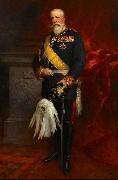 |
Ferdinand Keller
|
|
Ferdinand Keller (born 5 August 1842 in Karlsruhe; died 8 July 1922 in Baden-Baden) was a German painter.
|
|
|

